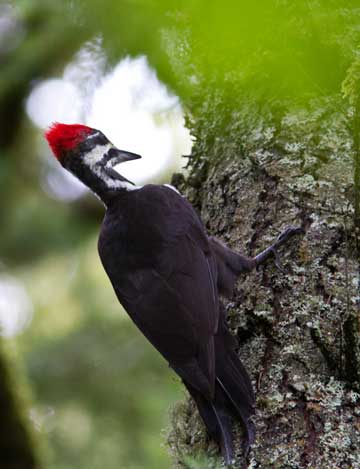 |
Previous Issues |
| Cedar Mill Community Website |
|
Search the Cedar Mill News: |
About The Cedar Mill News |
|
|||||||
| Volume 9, Issue 12 | December 2011 |
||||||
It’s cold outside
|
 |
| A female Pileated woodpecker in Cedar Mill. Photo © 2011 by Jeff Young. |
Most of the birds that must have warmth, or have specific nectar or insect foods, have migrated south. Every year people worry that leaving out hummingbird feeders might encourage those hummers to stay who need to leave. Don’t worry about this. The best evidence is that migration is related to day length, not food availability, so leave the hummingbird feeder out for the Anna’s hummers who do stay in Portland all winter.
As the nectar from flowers dries up, those birds tend to feed off of sap and any remaining insects. Hummers have been demonstrated to be able to reduce their metabolic rates over the winter so as not to have to eat as much. But I have seen hummers in freezing temperature try to eat out of frozen feeders. My husband rigged up a warming lamp to shine on the hummingbird feeders for the ones who were hungry. Alternatively, you might bring in your feeder at night so that it stays fluid to put out again in the morning (assuming it warms up during the day!). For hummingbird mixtures to freeze it has to be really cold, since the dissolved sugar freezes at a lower temperature than plain water. However I have had frozen feeders for several days in most of our winters.
Non-nectar eating species also can have trouble finding natural sources of seeds or insects. Black sunflower seed is high in energy and very appealing to a wide variety of songbirds. The foods containing millet have not been that successful for my feeders. I wonder if those mixes are more for other areas of the country. Maybe mine are picky! Other treats that attract birds to my yard are cut oranges, which I impale on a nail on my bird feeder—towhees and thrushes in particular like fresh fruit.
Many birds “flock up” in winter to stay warm together, avoid predators and help find food. In Cedar Mill we see large flocks of Bushtits, sparrows of several sorts, Chickadees and Juncos.
It is helpful to provide clean water. Certainly with lots of rain there are innumerable puddles. However puddles in the street can be contaminated with oil, runoff of yard chemicals, and other contaminants from asphalt. Maintaining a birdbath that is clean and free of ice in the winter is a huge gift to birds. We use a special low-voltage birdbath heater, which is safe to put into the water to keep it ice-free, and we are rewarded with innumerable woodpeckers, sparrows, the few hardy Goldfinches who brave the cold, and even hawks drinking out of our birdbath. A few drops of chlorine bleach in the birdbath ensures that no mold will grow in the winter.
Suet is a favorite winter food of many birds including nuthatches, chickadees, finches, sparrows, towhees and woodpeckers. If you note any sick birds be sure to clean your feeders more often. I wrote a posting about cleaning out hummingbird feeders and this still needs to be done in winter albeit less often. Many people don’t think of cleaning suet feeders but they should be cleaned often as well.
The loss of leaves allows us to see the birds more clearly. Our woodpeckers are more easily viewed pecking for insects. In Cedar Mill we have several types of woodpeckers including the Downy, the Hairy, several Flickers, an occasional Sapsucker species and sometimes even the rare and impressive Pileated. If it’s a nice day and you want to go for a short walk, consider going to the Hillsboro Library. In the dense oak woods to the south and southeast is a kind of woodpecker rarely seen outside of this small area in Oregon—the Acorn Woodpecker. These old oaks are riddled with holes in which these birds stash their winter cache of acorns.
Winter can be a great time to help hungry birds, while allowing you to view them more closely than you might in the other seasons where more food is available to them. One of my all-time favorite winter activities is sitting in my comfy chair with my cat and either a book or knitting and every once in a while glancing up to see which birds are at my window feeder. Sometimes I count but mostly I just enjoy…
Lauretta Young MD is a retired psychiatrist who now teaches mind and body health and health care management. She is a Professor at PSU and OHSU. She is the owner of a private bird tour company. People go birding with her in Cedar Mill and beyond—see the site at www.portlandbirdwatching.com. Visit Jeff’s photo site for more photos at www.flickr.com/photos/youngbirders
Published monthly by Pioneer Marketing & Design
Publisher/Editor:Virginia Bruce
503-803-1813
PO Box 91061
Portland, Oregon 97291
© 2011